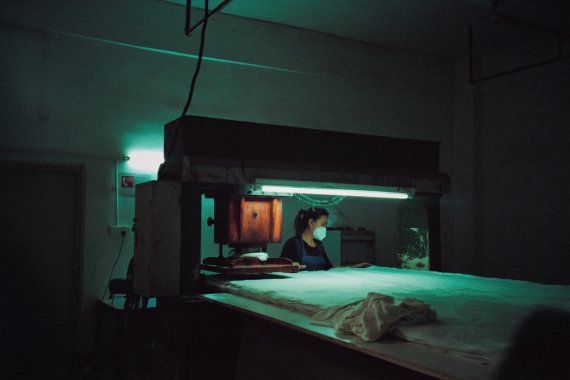Whether in shoes, backpacks and bags or in clothing - if they are well cared for, leather products are long-lasting, look sleek and are as flexible and supple as they are sturdy. Ideal, for example, for hiking boots that have to withstand great stress over a long period of time and still need to be comfortable. But leather also has its downsides. Anyone looking for information on sustainable materials in the textile sector these days will quickly stumble across vegan leather.
Vegan leather is made without the use or processing of animal materials. Strictly speaking, the material cannot be real leather, as this is obtained from animal skin and then processed. As a vegan alternative, instead of animal skin, synthetic material and plant fibers are processed in a similar manufacturing process to create a material that looks very similar to conventional animal leather.
Vegan materials are considered sustainable and environmentally friendly, so is the alternative to leather. In addition, there is no animal suffering in the manufacturing process. Moreover, even bone glue is completely dispensed with in the production of vegan leather.
In addition to sustainability aspects, there are also price advantages. Genuine leather is known for being expensive, but the vegan alternative is usually far less expensive. Of course, it should be noted that the price is ultimately strongly oriented to the processing and the sales brand.
A look at the manufacturing process makes it clear that vegan leather not only offers advantages in terms of sustainability and environmental protection. The production is namely carried out through the use of synthetic materials. A wide variety of chemicals and fossil fuels are used in the process, for example. Commonly used substances such as polyurethane or polyvinyl chloride lead to health problems in the worst case. The plasticizers they contain are also a cause for concern.
Due to the high demand for vegan leather, new methods are constantly being developed and implemented. For example, there are already leather alternatives made from pineapple leaf fibers or mushrooms. But even here, environmentally harmful processes such as the PU coating are used to extend the durability of the material.
The label "vegan leather" gives the impression that it is an environmentally friendly alternative to classic animal leather, and considering the animal welfare aspect, this is quite true. However, the synthetic materials used in its manufacture are anything but sustainable. In addition, vegan leather is also not biodegradable. Although the label vegan is associated with sustainability by most consumers, this is unfortunately not the case in the case of leather. Regrettably, depending on the manufacturing process, the materials are even partly harmful and can endanger health.

It may sound surprising to some, but genuine leather offers several advantages over the vegan variety. Namely, animal leather is biodegradable, breathable, long-lasting, comfortable, and sometimes leftovers from meat productionare utilized in themanufacturing process .
From some aspects, genuine leather is even more sustainable because of its durability. And as we all know, it is best for the environment if new products are bought in the first place. Moreover, biodegradability is an important criterion for sustainable products.
Nevertheless, it must not be forgotten that leather production is directly related to the meat industry. Although the production of leather goods from leftovers reduces the amount of waste, meat industry is anything but sustainable. In addition to the immense amount of water used (15,415 liters for 1 kg of beef), animal agriculture is also responsible for approximately 15 to 20 percent of environmentally harmful carbon emissions.
In addition, the production of leather involves chemical treatment through chrome tanning. takes place. Chrome is a toxic color and therefore not harmless to human health, which can also have negative effects on the environment. A more sustainable alternative is, for example, vegetable tanning, but unfortunately not all leather manufacturers resort to it.
It is not possible to make a general statement about which variant is better. The most common manufacturing processes of both variants are not entirely harmless to the environment and health. The question is therefore to what extent you can reconcile the purchase of a product with your own values. Vegan leather is undoubtedly better for the animal world, but the products can be harmful to humans and the environment, as the products are not biodegradable and environmentally harmful and hazardous chemicals are used in the manufacturing process.
Therefore, before buying a product, it is recommended to take a closer look at the manufacturing process. This applies to both animal and vegan variants. As already explained, genuine leather, for example, is partly made from vegetable tanning and vegan leather often consists of pineapple, mushroom or cactus leather. Unfortunately, these manufacturing methods are not guaranteed by all suppliers.
Therefore, you should consider these criteria when making your decision.
The alternative to classic leather is particularly suitable for people who care about animal welfare. If it is purely about the sustainability aspect, it must be individually checked for the respective product whether it meets the criteria mentioned.
In addition, vegan leather is suitable for anyone who wants to save some money when buying their products. Of course, you may have to sacrifice something in terms of appearance and quality, because textiles made of genuine leather often have a higher quality appearance and are also more durable. But that doesn't mean that textiles made of vegan leather can't be stylish or are even inferior in quality, quite the opposite. Even with furniture and accessories, the visual differences are often minimal.
In the meantime, vegan leather is no longer made exclusively from polyurethane (PU) and polyvinyl chloride (PVC). manufactured. In the meantime, the following raw materials are also used in production:
Mushroom Leather
A hitherto rather unknown manufacturing method is the production of leather from mushrooms. The mushroom species "Zunderschwamm" has its home in Bavaria and in some other regions of Germany. This is a good alternative for those who also consider regional aspects. Mushroom leather is ideal for textiles, because the material is comparatively breathable and also very soft.
Cork
Cork is considered a very sustainable material. It is made from the cork oak tree and the trees do not have to be felled for the raw material extraction. Peeled trees produce cork by themselves and also produce four times as much oxygen as unpeeled trees. Cork leather is also considered breathable, waterproof and warming.
Wine Leather
This manufacturing method is based on grapes and their skins, stems and seeds. The processing method combines oil and the fibers to create a leather-like surface.
Apple Leather
The so-called "appleskin" iscreated from the remains of the apple industry . In this process, approximately 70 percent consists of apple residues and the remaining 30 percent of polyurethane. Even though this substance is responsible for the stability of the manufactured products, polyurethane is not good for the environment. Therefore, Appleskin cannot be classified as an environmentally friendly alternative.
Cactus Leather
The unique structure of the Nopal cactus looks confusingly similar to real leather. In addition, during the production of Cactus leather hardly water needed and it completely avoids the use of synthetic materials. Due to its high durability, cactus leather is perfect for processing into fashion, accessories, furniture and clothing.
Pineapple Leather
Many vegan leather varieties are made from fruits. Most famous is pineapple leather, also known as Piñatex. The leather is made from the fibers of pineapple leaves. This makes the material robust and because the fruit is readily available, products made from piñatex are relatively inexpensive.
Products made of vegan leather also require care so that they last as long as possible. Shoes are best cleaned with a soft brush with which you can gently apply pressure. Car seats should be wiped in the direction of the grain. Handbags, on the other hand, are best impregnated with a spray beforehand and then cleaned with a damp cloth as needed.
Important: General tips like these do not apply to all products. Therefore, it is best to always follow the care instructions for the respective leather to be on the safe side.
Contrary to many assumptions, vegan leather is not a greenwashing-trick to sell products better, because there are actually crucial differences to artificial leather. The main feature of vegan leather, as the name suggests, is that it is manufactured without any animal products. The production of artificial leather, on the other hand, only avoids the processing of animal skins, Bone glue is still used.
So artificial leather is not the same as vegan. Therefore, pay close attention to the designation, because imitation leather may only be called vegan if actually no animal products were processed.

What is clear is that vegan leather offers an animal-friendly and affordable alternative to genuine leather. However, mostly at the expense of the environment. Although leather alternatives made from fruit in particular are comparatively environmentally friendly, chemical substances are often used here as well. Anyone who really wants to live sustainably should therefore find out exactly about the manufacturing process and weigh up which leather variant fits better with their personal values. In any case, it is important to care for the products properly, no matter which material you finally choose. This way you can wear the leather goods for years without having to buy new products, which is ultimately best for our environment.
What Is a PU Coating?
It is a protective layer made of polyurethane (PU). The coating serves as a durable impregnation process to provide protection against moisture. However, PU coating is harmful to the environment and health.
Is Vegan Leather Waterproof?
Vegan leather is waterproof in most cases, but only with an appropriate plastic coating.
Is Vegan Leather Plastic?
In most cases, the basically environmentally friendly materials such as pineapple leather or cork, are coated with a plastic layer of polyvinyl chloride or polyurethane. Thus, the products are vegan, but not sustainable.
- ISPO awards
- Mountain sports
- Bike
- Design
- Retail
- Fitness
- Health
- ISPO Job Market
- ISPO Munich
- ISPO Shanghai
- Running
- Brands
- Sustainability
- Olympia
- OutDoor
- Promotion
- Sports Business
- ISPO Textrends
- Triathlon
- Water sports
- Winter sports
- eSports
- SportsTech
- OutDoor by ISPO
- Heroes
- Transformation
- Sport Fashion
- Urban Culture
- Challenges of a CEO
- Trade fairs
- Sports
- Find the Balance
- Product reviews
- Newsletter Exclusive Area
- Magazine







